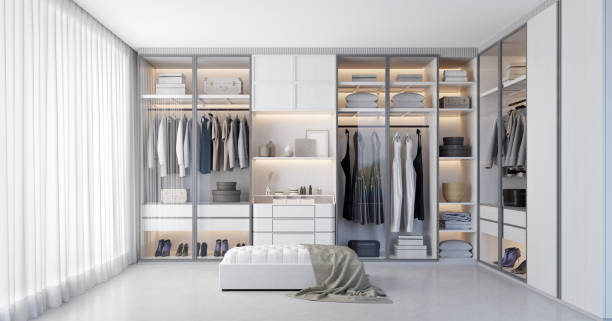Understanding Fitted Wardrobes and How They Work
Learn how fitted wardrobes use every corner of a room to store clothes and other items neatly. This article explores the different styles, parts like shelves and drawers, and ways people arrange their belongings so everything stays organized and easy to find.

Custom Wardrobe Systems: Design and Installation Process
Custom wardrobe systems begin with professional measurement and design consultation. Designers evaluate the space, considering room dimensions, ceiling height, alcoves, sloped ceilings, and other architectural features that might affect the wardrobe design. Advanced 3D modeling software often helps visualize the final product before manufacturing begins. The installation typically involves securing a framework to walls and floors, followed by the addition of custom-made panels, doors, and internal components. Professional installation ensures stability and proper alignment, with the process typically taking 1-3 days depending on complexity. The result is a precisely fitted storage solution that appears as though it was built with the original structure.
Fitted Wardrobe Design: Style Options and Materials
Fitted wardrobe design encompasses numerous style options to complement any interior design scheme. Contemporary designs often feature clean lines, minimalist hardware, and glossy finishes, while traditional styles may incorporate wooden frames, paneled doors, and decorative moldings. Material choices range from economical melamine and laminate boards to premium solid woods like oak, walnut, or cherry. Door styles vary widely, including hinged doors, sliding doors (ideal for smaller spaces), and bi-fold options. Mirrored doors remain popular for their dual functionality of storage and reflecting light to make rooms appear larger. Many manufacturers also offer specialized finishes like matte, high-gloss, or textured surfaces in virtually any color to match or contrast with existing room décor.
Wardrobe Storage Solutions: Internal Organization Features
The true advantage of fitted wardrobes lies in their customizable internal storage solutions. Modern systems offer numerous organizational components that can be tailored to specific storage needs. These typically include adjustable hanging rails at various heights for different garment types, pull-out trouser racks, tie and belt organizers, and shoe storage solutions. Drawers can be configured in multiple depths and widths, while shelving can be fixed or adjustable to accommodate changing storage requirements. Additional specialized storage includes jewelry trays, pull-down hanging rails for higher spaces, pull-out baskets, and integrated laundry hampers. Many systems also incorporate built-in lighting options—sensor-activated LED strips or spotlights that illuminate when doors open—making it easier to locate items in deeper sections of the wardrobe.
Space-Saving Wardrobe Ideas for Challenging Rooms
Fitted wardrobes excel in challenging spaces where standard furniture would be impractical. For awkward room layouts, corner units with specialized mechanisms maximize otherwise unusable areas. In rooms with sloped ceilings, custom-cut wardrobes follow the ceiling line precisely, utilizing space that would otherwise remain empty. For small bedrooms, floor-to-ceiling designs with sliding doors eliminate wasted space above traditional wardrobes while avoiding the clearance needed for hinged doors. Under-stair areas can be transformed into valuable storage with tailor-made solutions that follow the exact angle of the staircase. Even alcoves and chimney breasts can be incorporated into the design, with wardrobes wrapping around these features for a seamless look that transforms architectural challenges into storage advantages.
Built-in Wardrobe Storage: Cost Considerations and Planning
The investment in built-in wardrobe storage varies widely depending on materials, complexity, and size. Basic fitted wardrobes with standard interiors typically start around $1,000-$3,000 for smaller installations, while premium systems with luxury finishes and extensive customization can range from $5,000 to $15,000 or more for walk-in designs. Costs are generally calculated per linear foot, with additional charges for specialized interior fittings and premium door options.
| Wardrobe Type | Average Cost Range | Key Features |
|---|---|---|
| Basic Fitted Wardrobe | $1,000-$3,000 | Simple interiors, standard doors, melamine or laminate finishes |
| Mid-range Custom System | $3,000-$7,000 | Better quality materials, more internal organization, sliding door options |
| Premium Built-in Solution | $7,000-$15,000+ | High-end materials, extensive customization, specialized lighting |
| Walk-in Wardrobe Conversion | $10,000-$30,000+ | Complete room conversion, luxury finishes, comprehensive organization systems |
Prices, rates, or cost estimates mentioned in this article are based on the latest available information but may change over time. Independent research is advised before making financial decisions.
Maintenance and Longevity of Fitted Wardrobes
Properly installed fitted wardrobes offer exceptional durability, with quality systems lasting 15-25 years or more. Their maintenance is generally straightforward—regular dusting and occasional wiping with appropriate cleaners keeps surfaces in good condition. Unlike freestanding furniture, fitted wardrobes don’t collect dust on top or behind them, contributing to better air quality. Hardware components like hinges, runners, and handles may require occasional adjustment or lubrication to maintain smooth operation. One significant advantage is the ability to refresh the appearance without complete replacement; doors and hardware can be updated to follow evolving design trends while keeping the internal framework intact. This modular approach makes fitted wardrobes a sustainable long-term investment that adapts to changing storage needs and aesthetic preferences.




